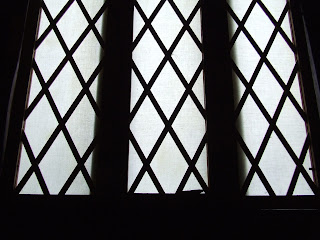 |
| Glazing with horn rectangles |
During my recent trip to York for the Jorvik Viking Festival, I also made a visit to Barley Hall, a medieval townhouse down an alley off Stonegate – all this well within the walls that would have surrounded the Roman fortress.
The oldest parts of the building date from 1360 when it was built as the city’s townhouse for Nostel Priory, a monastery near Wakefield 35 miles distant by modern roads. The building gained a second wing around 1430 and became the home of one William Snawsell, goldsmith, alderman and Lord Mayor of York.
How it looks today was not how it looked down the later centuries. Like many a medieval building in the UK it was hacked about, re-roofed in tile or slate, covered in brick and/or its exterior replastered. The York Archaeological Trust gained possession of the then decrepit building in 1987 and, after remedial and replacement work using techniques from the period, it was opened to the public in 1993.
The oldest parts of the building date from 1360 when it was built as the city’s townhouse for Nostel Priory, a monastery near Wakefield 35 miles distant by modern roads. The building gained a second wing around 1430 and became the home of one William Snawsell, goldsmith, alderman and Lord Mayor of York.
How it looks today was not how it looked down the later centuries. Like many a medieval building in the UK it was hacked about, re-roofed in tile or slate, covered in brick and/or its exterior replastered. The York Archaeological Trust gained possession of the then decrepit building in 1987 and, after remedial and replacement work using techniques from the period, it was opened to the public in 1993.
 |
| Horn rectangles overlapping like roof tiles |
I was particularly interested in the size of the windows, considering glazing with glass was appallingly expensive until relatively late (17th century). At Barley
Hall residents overcame this by two methods: oiled linen and horn.
Neither would allow the viewer to look out, only for light to enter. But
how much light?
Horn was quite plentiful: The Shambles (butchers’ row) is only a few streets away, and all cattle of the period would bear horns. These would be boiled to soften, slit open and flattened. Depending on the age and thickness of the horn, layers could be split away, and a usable rectangle cut. These would be fitted in a frame to overlap slightly so that rain would run down the outer side.
Horn was quite plentiful: The Shambles (butchers’ row) is only a few streets away, and all cattle of the period would bear horns. These would be boiled to soften, slit open and flattened. Depending on the age and thickness of the horn, layers could be split away, and a usable rectangle cut. These would be fitted in a frame to overlap slightly so that rain would run down the outer side.
It looked extremely durable, and one window is said to be the oldest in England.
 |
| Oiled linen stretched on a frame |
Fine linen, perhaps a textile such as would be used for an ordinary person’s chemise/under-shirt, would again be fitted into a frame and oiled using linseed.
How many coats, and how often the material would need re-coating wasn’t obvious, but it is certainly a far quicker method. Both allowed a surprising amount of light in, even on the light-cloud day when I visited.
 |
| Oiled linen top / horn bottom |
Perhaps even ordinary medieval homes, never mind the halls of the wealthy, weren’t quite the dark and dingy hovels we imagine.
See also my post on medieval Gainsborough Old Hall in Lincolnshire.

Wow! This article and the the one after it( Gainsborough Old Hall) are so full of information. I love reading about tidbits of how the people of old lived.
ReplyDeleteThanks for calling by to read - and to comment. It is this aspect which has always fascinated me. I really don't care much about the political intrigue most readers go for, it's the day to day ordinariness of "how did they..." that I find so compelling. Glad you do too!
DeleteYou'll probably enjoy my post on Orkney's Skara Brae